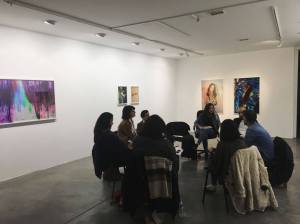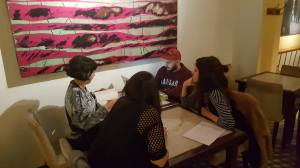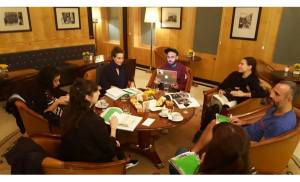COLLECTIVE CUKURCUMA READING GROUP – 2nd semester
Founded by Gökcan Demirkazık, Mine Kaplangı and Naz Cuguoğlu, Collective Çukurcuma Reading Group will have monthly meetings and invite our friends to assign a reading, we will read, talk and discuss.
WEEK XX
Date – Thursday, June 22nd, 2017
Location – Galata Greek School
Number of participants – 10
Selected Texts – Camus: The Myth of Sisyphus, The Private Lives Of Rocks, Reading the Rocks: Flood Stories and Deep Time
Link for the texts –
dl=0https://www.dropbox.com/s/hr12ubqtkh3j41g/Myth%20of%20Sisyphus.pdf?
https://www.dropbox.com/s/pp5x88u20p0vize/The%20Private%20Lives%20of%20Rocks.pdf?dl=0https://www.dropbox.com/s/vxlwl2iu28ukhxk/The%20Rocks%20Flood%20Stories%20and%20Deeptime.pdf?dl=
Discussion questions –
1. If Yannis knew that he would not be able to leave the island, would he still paint the stones?
2. What are the similarities between the myth of Sisyphus and our lives?
3. What is the importance of freedom of thought and action to break the cycle? (page 19)
4. Comment more on the “endless spiral of existence” mentioned by Yannis in the film. And compare it with the “acts of a mechanical life” by Camus.
5. Was Sisyphus really punished or was he a free man eventually through his actions? What is the role of free will?
6. What is the meaning of absurd in Albert Camus’ existential philosophy?
7. What is the relation between the philosophical suicide and living with the absurd according the myth of Sisyphus?
WEEK XIX
Date – Wednesday, April 12th, 2017
Location – ArtSümer
Number of participants – 9
Selected Texts – On Bahar Yürükoğlu’s “Maybe I’d like to be like you” exhibition
Link for the texts –
I Love Dick by Chris Kraus –
https://www.dropbox.com/s/ag9gwm17p9p40ez/Kraus_I%20Love%20Dick_Extract.pdf?dl=0
Discussion questions –
1. What kind of position does Bahar Yürükoğlu take vis-à-vis reality? Does she emerge as a fiction maker or a conveyor of reality? If so, what kind of reality?
2. In which ways is loving something/someone can be wanting to be it/him/her?
3. What kind of ritualistic elements does Bahar Yürükoğlu’s practice have? What is its relations to death?
WEEK XVIII
Date – Thursday, March 9th, 2017
Location – BLOK art space
Number of participants – 9
Selected Texts –
* Merak Özbek, “Arabesk Kültür: Bir Modernleşme ve Popüler Kimlik Örneği”
* Ahu Antmen, “Cinsiyetli kültür, cinsiyetli sanat: 1970’lerden 1980’lere Türkiye’de toplumsal cinsiyet ve kadın sanatçılar”
* Erden Kosova, “Yavaş Kurşun II”
* Murat Belge, “Bir afiş dolayısıyla devrimci resim üstüne”
* Meltem Ahıska, “THE IMPERIAL COMPLEX AND GLEANING THE WONDERS OF MODERNITY”
Link for the texts –
https://drive.google.com/drive/folders/0B5ZUG229S0QvR3NySmh4d1pDRmc
Erden Kosova, “Yavaş Kurşun II” – http://www.red-thread.org/tr/makale.asp?a=26
Discussion questions –
– How has the transformation of the art scene in Turkey (especially the institutionalization of the later 1990s) influenced Gülsün Karamustafa’s work?
– What does the profile of owners of Gülsün Karamustafa’s early work tell us about the Turkish contemporary art world & history?
– What kind of critique is present in Gülsün Karamustafa’s interpretation of arabesk? What is her position (an insider or a looker-on)? We can compare her work to that of CANAN vis-à-vis arabesk to discuss this topic.
– In Gülsün Karamustafa’s generation of artists, what is the relation between activism and artistic practices?
WEEK XVII
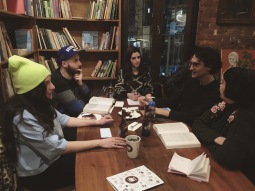
Date – Friday, February 17th, 2017
Location – Türk-Alman Kitabevi
Number of participants – 5
Selected Text – Selected Texts from Dissonant Archives: Contemporary Visual Culture and Contested Narratives in the Middle East, edited by Anthony Downey
Link for the texts –
Discussion questions –
-What does “constituent violence” mean?
-How do the writers define archive differently in the two texts?
-Is it really possible to use old methods of archiving for online archives?
-How are old photographs used to construct perception about today? (In Turkey – In relation to the Republic Period)
-Why does the tendency of private collection to act publicly exist both in Turkey and Egypt? What are the main motivations / reasons?
-How can we create objective archives that are open to public?
WEEK XVI
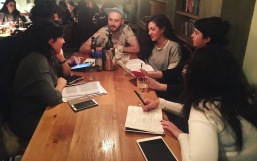
Date – Friday, January 20th, 2017
Location – Journey
Number of participants – 6
Selected Text – Selected Texts from Dissonant Archives: Contemporary Visual Culture and Contested Narratives in the Middle East, edited by Anthony Downey
Link for the texts –
Coming to Terms Contemporary Art, Civil Society and Knowledge Politics in the ‘Middle East’ by Tom Holert
Arab Digital Expression Foundation by Laura Cugusi
Discussion questions –
-What is the role of infrastructure in terms of archiving? How does it change according to the geography?
– What is the role of translation and the language while talking about politics related to Middle East?
-Does Tom Holert conflict with himself when he uses theories of Foucault to talk about the issues in Middle East?
– What are the similarities between Egypt and Turkey in terms of politics and cultural institutions? (Ex: The use of word “martyr”)
– What does “political economy of knowledge” mean in relation to Middle East? Are we part of this? What can we do about this?
– What does post-truth mean in digital age?
WEEK XV
Date – Wednesday, December 28th, 2016
Location – Şimdi Cafe
Number of participants – 4
Selected Text – Selected Texts from Dissonant Archives: Contemporary Visual Culture and Contested Narratives in the Middle East, edited by Anthony Downey
Link for the texts –
Anthony Downey – “Contingency, Dissonance and Performativity: Critical Archives and Knowledge Production in Contemporary Art” –https://www.dropbox.com/s/evn9ichwpt0hvuw/Downey_Introduction.pdf?dl=0
Chad Elias – “The Museum Past the Surpassing Disaster, Walid Raad’s Projective Futures” – https://www.dropbox.com/s/kxzh8ubp2fti0xl/Elias_Walid%20Raad%20%281%29.pdf?dl=0
Discussion questions –
– How do we define the ongoing relationship between the contemporary art and the archive?
– What forms of knowledge are being produced in the moment- when art interacts with archives?
– How can we discuss “performativity” in the context of “archives as art forms”?
– Under which circumstances an archive or an archival work can become “a call for action”?
– What is the main idea behind Walid Raad’s concept of “surpassing disaster”?
– What is the relationship between Jalal Toufic’s “immaterial withdrawal of tradition” and the concept of “surpassing disaster”?
WEEK XIV
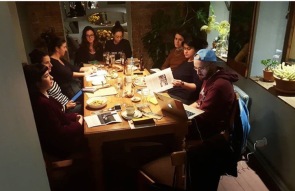
Date – Thursday, November 10th, 2016
Location – Cuma Cafe
Number of participants – 9
Selected Text – Superhumanity // Readings on 3rd Istanbul Design Biennial
Link for the texts –
Colomina & Wigley – Homo Cellular & Design in 2 Seconds https://www.dropbox.com/s/ohpifd2lgghc4m4/20161108100235272%20%282%29.pdf?dl=0
Boris Groys – Self-Design, or Productive Narcissism – http://www.e-flux.com/ architecture/superhumanity/ 66967/self-design-or- productive-narcissism/
Discussion questions –
-In secular societies, one’s relation to unknown multitudes (fame, social media following) have replaced God.
-What is the relationship between ubiquity of labor(ing) (Colomina & Wigley) and the desire to be desired?
-In what ways personal communication methods/manners have merged with professional communication methods/manners?
-Can one consider solitude and popularity on two ends of a spectrum while “uniqueness” stands in the middle as a reflecting/refractory surface in the middle, allowing for “jumps” between these two ends?
-Use of mobile devices has decreased the capacity of our short-term memory, yet enhanced our long-term memory.
-What is the difference between taking selfies and writing a diary?
WEEK XIII
Date – Friday, October 14th, 2016
Location – Pera Museum
Number of participants – 7
Selected Text – Selected texts from Katherine Behar’s “Data’s Entry” exhibition catalogue
Link for the texts –
“Reset Factory Settings” by Fatma Çolakoğlu & Ulya Soley
“Seeing Things in Data Visualization” by Katherina Behar
Discussion questions –
-What are some of the main ideas behind “Katherine Behar: Data’s Entry” exhibition?
-Can objects and humans co-exist in a more democratic setting?
-How can we talk about the Data’s Entry exhibition in a post-human or post-gender context?
-What are some similar examples in the popular visual culture?

